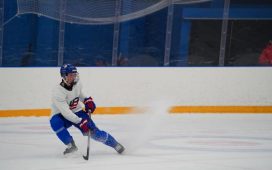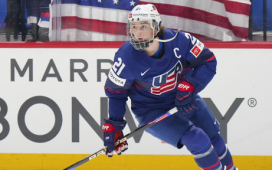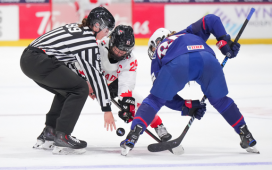Excerpt adapted from “Toe Blake: Winning is Everything” by Paul Logothetis. © by Paul Logothetis. Published by ECW Press Ltd. www.ecwpress.com
“The Mad Dog Line” was a fitting name for the original Punch Line.
After Benoit left the Canadiens in 1943 to serve in the war, the injury-prone Maurice “Rocket” Richard would be elevated to play alongside Blake and Lach. The Rocket’s potential was certain, but his ability remained somewhat of a mirage after two injury-plagued seasons. Blake, meanwhile, had already firmly established his status as a star in the league.
“Toe was obviously better than average. He did not need the Rocket to help him—he was a star before the Rocket. He was right up there. Not at the top with Howie Morenz, but he was very good,” Fischler remembered. “I don’t know how good the Rocket would have been without him as a winger at that time. (But) the most significant thing Toe did as a player was his ability to integrate himself with Lach and the Rocket and turn them into a tremendous team. As a player, he was superior.”
Blake welcomed this combination, as he now found himself on the other side of thirty. Playing alongside Lach and Benoit had helped him rediscover his best qualities as a player. The resurgence of Blake as a superstar was the talk of the league. Some said his play at the end of the 1941–42 season was better than that of his Hart Trophy–winning season as scoring champion, or of his First Team All-Star season one year later.
[. . .]
“Right after I turned 30, Dick (Irvin) told me I would have to drive harder, just to break even. It sounded silly at the time but he was right,” Blake told The Hockey News years later. “Every season after that, hockey was more like work and less like fun. A broken leg finally stopped me. I might not have gone that far if I hadn’t been playing with a great club.”
Being paired up with Lach and Benoit was the first step in maximizing Blake’s output. When center Terry Reardon left to perform military service, Irvin slotted Lach into the line for a December 19, 1942, 1–1 draw with the New York Rangers. The line really came together in back-to-back weekend games against Boston and Toronto to start the new year, when it racked up 16 points. Because of injury, Maurice “Rocket” Richard didn’t return to the fold until the following season, missing out on the Canadiens’ 4–1 playoff series loss to the Bruins. With the downsizing of the league to the “Original Six,” best-of-seven playoff series now became the norm, and the red line was introduced to rid the game of “pitch and toss” hockey. A faceoff rule was also introduced, forcing both centers to stand square to the puck before it was dropped.
The former initiative aided the Punch Line when Richard joined in. It was Blake “the coach” who appeared to promote the Rocket to the top line: Blake scored a pair of goals in a 3–1 win over the Bruins on December 19, 1943, after having missed out on five games to an injured shoulder; Irvin flew home after the victory to spend the holidays back in Regina, leaving trusted apprentice Blake to run practices until he returned from the holiday break. “Dick Irvin made a happy choice when he left Toe Blake in charge of the practices,” the Montreal Gazette reported. “Toe has not been a soft touch, by any means. He has had the players going at top speed in the practices all week and they should be in fine condition when they face the Hawks.”
[. . .]
“Playoff Madness” seized the city amid expectations the club would end a 13-year Stanley Cup drought. On the eve of the semifinal series against the third-place Toronto Maple Leafs, thousands thronged the box office by 6:30 a.m., in anticipation of tickets going on sale at 10. Scalpers were demanding $25 for a pair that normally would cost $5 each in the regular season. The Canadiens hadn’t lost at the Forum for over a season, a stretch of 25 games; perhaps that explained why Irvin was cautious on the eve of the match. The Maple Leafs surprised with a 3–1 win to open the series. Leafs goalie Paul Bibeault—on loan from the Canadiens, with Durnan the clear number one—made 61 saves, with only Blake getting on the scoresheet, when it was already 3–0. “We all lacked drive except Toe Blake,” winger Murph Chamberlain said.
But the law of averages was on the Canadiens’ side, especially with their balanced attack. The Punch Line led the way, and the Rocket broke out to score all five goals in a 5–1 win that evened the series, with Blake getting assists on all five tallies. The previous record for goals in a playoff game was three, an accomplishment achieved by Blake against the Black Hawks in 1938.
The Canadiens moved on to Maple Leaf Gardens and its pigmented ice, which was almost as dark as the puck. The color made no difference, as the Canadiens swept the remaining games, with Blake netting two goals in the series-clinching 11–0 Game 5 win in front of 13,215 on the milky-colored Forum ice. Not only was the scoreline a new record, but the five goals the Canadiens scored in 3:36 was also a playoff first. The Leafs were forced to open up and chase the game, and paid the price—the Canadiens were too fast, too rugged, and too precise for their young opponents.
Chicago, meanwhile, had also needed five games to dispatch Detroit. When the Stanley Cup Final series began over the Easter weekend, the Montreal Gazette reported, “the ladies were all out in their holiday finery, and bright colors added to the spectacle. Despite the air of respectability, Chicago fans came prepared with missiles to the event, with police confiscating coat hangers, steel bolts, smoked fish, bags of rice and flour, fruit, boxes of soap flakes, rolls of toilet paper, megaphones, candies, bottles, large and small bells, pieces of steel, rolls of coins and several folding chairs.” The Canadiens weren’t intimidated; they won two tight, physical games in Chicago to take a 3–0 series lead back to the Forum.
[. . .]
Chicago’s Smith-Bentley-Mosienko line may have been one of the NHL’s finest, but in the final they were no match for the Punch Line. Blake, Lach and Richard not only carried the attack but were a coach’s dream: they did not have a single goal scored against them in the playoffs.
The anticipation of Game 4 and a first Stanley Cup since 1931 was brewing before puck drop on April 13, 1943. The Canadian Arena Company—owners of the Forum—took the protective measure of compelling boys under 16 to sit in the north end unless accompanied by an adult, since so much damage had been done to the building by teenagers.
Going into the third period, though, it wasn’t just the teenagers who needed to be surveyed. The near 13,000 spectators were so disillusioned by the 4–1 deficit after two periods that when the Habitants emerged into a smoke-filled arena to start the third, they were met by chants of “fake, fake” by the home fans, who were testing their championship mettle.
The stage was set for the Punch Line to star, and it was Blake who took the lead. The “grand old warrior” was the catalyst as he “broke up the game in typical Blake fashion.” He racked up four assists, feeding Richard for the game-tying goal with 2:20 remaining. Blake clinched the club’s fifth Stanley Cup by scoring the winner at 9:12 of overtime.
[. . .]
“There have been better hockey games in the Forum this year but none was more exciting than this one” the Montreal Gazette pronounced, while La Patrie featured a picture of the team with the Cup on its front-page beneath the headline “Dunkirk; Nazis in Crimea.”
[ . . .]
Blake’s strength, smarts and experience led the turnaround, and even alternate referee King Clancy sounded off on the difference maker saying, “It couldn’t have happened to a better guy.”
The celebrations continued through the night into the following day, when a victory luncheon was organized for the team at the Queen’s Hotel. Blake declared it was the best team he had ever suited up for. “I’m glad Rocket is on the line with me. He’ll make me good for another five years.”








